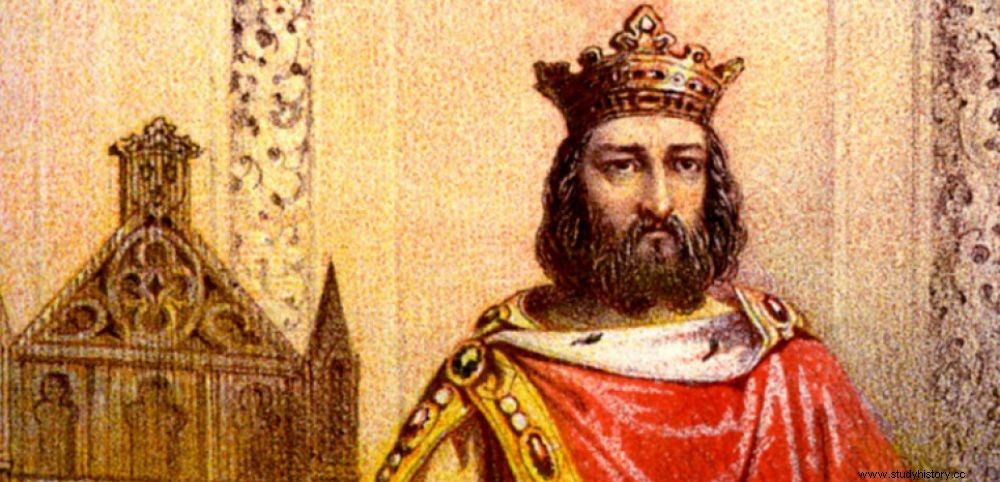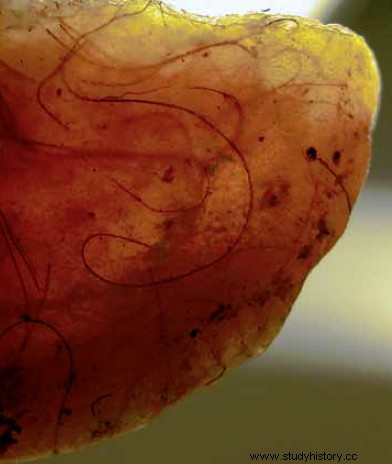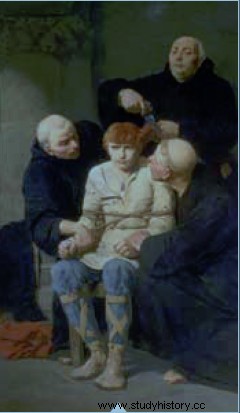 Charlemagne (742-814), King of the Franks, grandson of Charles Martel, Carolingian dynasty. Engraving from the end of the 19th, beginning of the 20th.
Charlemagne (742-814), King of the Franks, grandson of Charles Martel, Carolingian dynasty. Engraving from the end of the 19th, beginning of the 20th. POWER. Hair seems to have exercised incredible power among Merovingian and Carolingian rulers. The Frankish kings, known as the “hairy kings”, had they not gone so far as to deposit some of their precious capilli in their royal seals? In an article published this month in the journal Forensic Science, Medicine and Pathology under the direction of Philippe Charlier, the paleoanthropologist returns in detail to a study that we had published in Sciences et Avenir in September 2013 (in an article that we suggest you find below) .
Following analyzes carried out on royal seals kept at the National Archives of France in Paris, researchers had indeed been very surprised to discover that human hair was caught in the wax seals of several Carolingian sovereigns and Merovingians, starting with Childebert III, Chilpéric II, Pépin le Bref, or even Charlemagne. Deposited in wax, it seems that the function of these hairs and hairs was to reinforce and consolidate the executive power of the legal acts at the bottom of which they were placed, thus materializing the presence of the king. This practice seems to have continued for several decades. Many royal scrolls were indeed sealed with these hair-lined wax seals. A discovery that greatly surprised the researchers.
“When hair was king”, an article originally published in Sciences et Avenir n° 799

Judgment of 751 signed by Pépin le Bref ordering the restitution to the Abbey of Saint-Denis of lands of which it had been despoiled. The seal contains hair. © Agnès Prévost/National Archives
Paris, 2007, National Archives seal restoration workshop. Agnès Prévost, site manager, pauses. As she prepares to carefully handle a royal seal of Childebert III (683-711) intended for the “Rome and the Barbarians” exhibition in Venice, a detail intrigues her. Fibers seem to be flush with the wax imprint, where the face of the Merovingian monarch can still be seen in slight relief. Is it tow? Filasse from the protective bags that wrap the precious objects? She then examines a seal of Charlemagne (742-814), also about to be shipped to Italy. By transparency, she also observes the presence of many filaments wrapped in the wax. The curiosity of the researcher is piqued. To get to the bottom of it, the young woman then decides to put the precious relics under an electron microscope. And the surprise is total! These threads are organic matter, in other words… hair and mustache or beard hair! Did they accidentally get mixed up in the wax when printing the seal? “There were too many for them to have ended up there by chance! We had to admit it:this hair had been incorporated on purpose” , says Agnès Prévost. Since then, analyzes carried out with the historian Marie-Adélaïde Nielen on 50 Merovingian and Carolingian parchments kept in the National Archives, and still bearing their seals, have shown that eleven of them presented this particularity. Blond or brown, these capilli clandestine are for researchers a vivid reminder of a forgotten history.

Detail of a wax seal fragment of Chilperic II (670-721) revealing the presence of hair. © Agnès Prévost/National Archives
That of the power exercised by the hair among the Frankish kings, aptly named “reges criniti ”, “hairy kings”:Thierry III, Chilpéric II, Pépin le Bref, Charlemagne, Louis II le Bègue… To ensure the human origin of these components and enter into matter without breaking the seals, the researchers made appeal to the forensic doctor Philippe Charlier, of the university hospital of Garches, as well as to the Center for research and restoration of the museums of France (C2RMF). This confirmed the organic origin and specified that the hair had been pulled out, and not cut, as evidenced by the presence of bulbs. It remains to be confirmed, by DNA tests, that they belong to one and the same person and if they are indeed of royal origin… So many analyzes to be carried out. For historian Ghislain Brunel, chief curator of the National Archives, the royal origin of this hair is beyond doubt. “Du V e at X th century, under the Merovingians and the Carolingians, affixing his seal to the bottom of a parchment was an exclusive privilege of the sovereign.” Impossible to imagine a third party coming to deposit his hair on the seal of the king! At the time, only the latter could manipulate the seals on which his effigy appears. They are the ones who validate and authenticate royal documents. “The introduction into the seal of a fragment of the royal body, hair or body hair, was to reinforce the power of the document” , believes Marie-Adélaïde Nielen.
If they were struck by these new discoveries, the researchers were already well aware of the importance given to the hair by the Merovingians and the Carolingians. The Gallo-Roman bishop Grégoire de Tours (539-594) was the first to describe these “barbarian” leaders — so called because they were not Romans — as “hairy kings”. In particular when he evokes these sovereigns from the aristocracy of Germanic peoples from the mouths of the Rhine. Clovis (466-511), conqueror of the Roman Syagrius at Soissons (486) and first king of all the Franks, is presented with long hair. “In the tomb of Childeric, his father, the signet ring on which his face was engraved also shows him crowned with long hair” , adds Ghislain Brunel. It is therefore not surprising that the representations appearing on the seals refer to this hairiness.
This was also so important that it was part of rituals:thus, in 509, the Visigoth Alaric came to touch Clovis' beard as a sign of submission. Thierry III (654-691), king of Neustria, was shorn when he was deposed in 673, as was the Merovingian Childeric III (?-754), who was locked up in a monastery by Pépin le Bref in 751 .

The Merovingian Childeric III, deposed by Pepin the Short in 751, was tonsured before being locked up in a monastery. © Carcassonne Museum
Among the last Merovingians, the famous "lazy kings" quoted by the biographer of Charlemagne Éginhard, long hair is also a way of legitimizing one's offspring among the cloud of children born from multiple beds. We then understand better the words of Queen Clotilde (475-545) who, on the death of her son Clodomir in 524, opposed the tonsure of her three grandsons with a “rather dead than shaved ” . Cutting their hair was tantamount to removing any recognition of belonging to the royal lineage. Conversely, when the Franks were looking for a new king in 715, they brought the cleric Daniel (670-721) out of the convent, renamed him Chilperic, then waited patiently for his hair to grow back to place him on the throne! At the beginning of the Carolingian period, around 750, documents also mention ritual adoption of children by exchange of hair or beards. “This is what Liutprand, king of the Lombards, does with the young Pepin the Short, son of Charles Martel” , explains Ghislain Brunel. In return, Pépin will donate his hair to his adoptive father. According to the Benedictine Paul Deacon, in the VIII th century, cutting someone else's beard or hair was also a way of becoming their father
Hair is associated with military power
What are these customs related to? It is impossible not to imagine that these Christian leaders since the V th century do not refer to the hairstyles of the kings of the Old Testament and the symbolic force that they could derive from it, like a Samson. The prodigious power of this hero of the Bible indeed resided in his hair, which his wife, Delilah, treacherously cut off. “Nor should we rule out, on the part of these strongly Romanized Frankish chiefs, the desire to appropriate, in order to better assimilate, the fashion that was current in the legions in the V th > century, when the hair was worn long and not shorter as in the days of the Republic” , explains Ghislain Brunel. The Franks would not have been the only ones to associate hair with military power:“Among the barbarians, the Ostrogoths would also have been carriers of this custom. Tacitus mentions it in Germania, and Seneca too” , concludes the medievalist. Legend ? Reality ? This custom would have continued in the 15 th century:“To a document discovered in the 19 th century in the archives of Riom, supposed to be a letter that Joan of Arc would have addressed to the inhabitants of the city in 1429, hung a red stamp where we saw the mark of a finger and the rest of a hair... ” , adds Agnès Prévost. That of the Maid of Orleans?
